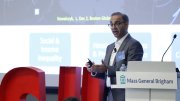Panelists:
Peter K. Bol, Carswell professor of East Asian languages and civilizations; director, Center for Geographic Analysis; chair, China Biographical Database Project
Tian Xiaofei, professor of Chinese literature
Is there a distinctive Chinese culture? Do “cultures” stand up under scrutiny, or when people from different traditions come into contact with one another?
Addressing the issue of who cares about Chinese culture, Peter Bol said that the idea of a single Chinese culture disappears upon close analysis. People within the supposed unitary culture in fact disagree on its meaning, as he learned during his studies of the Confucian classics. His teacher, a Qing dynasty prince, held strong views of proper Confucian behavior and learning—and held that others’ views were incorrect or deeply flawed. Even in the outward aspects of “culture,” there is no unifying principle: Chinese cuisine, Bol said, in fact consists of many different regional cuisines, many of which have themselves evolved and changed rapidly. Nor is there a unifying religious tradition, given the Chinese proclivity to generate multiple local gods alongside the international religions (from Buddhism to Christianity) that have had adherents at varying places and times. (For further information on Bol's research on Chinese local history, Chinese biography, and geographic information systems, see these earlier Harvard Magazine articles.)
Nor is culture defined by “nation.” Looking at the problem in American perspective, he asked, what unifies Americans, when they are sharply split over many fundamental political issues and points of view? In the current discourse, surely, radically divergent views of what constitutes American political culture are contending for support. Is American “lived culture”—Protestantism, large food portions, action movies—the same as being a “cultured American” (in the sense of being educated and cultivating wide interests and perspectives)? Not at all.
As for the sense of being cultured—as in the intellectual and aesthetic interests of the Chinese literati—that, too, he pointed out, was contested ground: at times, it was valued; at others, it represented a retreat from public life. In any event, in a Chinese history that extends back for millennia, this notion of culture arose only in the Song era, beginning in the ninth and tenth centuries, and became institutionalized only 900 years or so ago. This meaning of culture and the cultured Chinese is the one that many people today recognize—as a civilizing force that, in effect, domesticates the country’s rulers: it is a sense of adhering to moral values; the degree to which rulers do so determines their continued fitness to rule.
A challenge for educators today, Bol said, is to introduce students—Americans, for instance—to these other conceptions of culture and being cultured, so that they join their understanding of their own traditions or cultures to those of other people whom they will encounter in a globalized twenty-first century.
Tian Xiaofei approached the problem from a different angle: who cares about, or cares for, the culture? Given that Chinese culture is multifaceted, that it has incorporated foreign elements (from invading dynasties, and from diverse peoples included within the Chinese empire), it is an ever-evolving constellation, with unreconciled elements. In this perspective, she explained, the Chinese people believe that there is a core to their culture, but contend over its meanings and uses. The Web, she said, is a vigorous venue for airing such contests today, as users debate popular culture—novels, movies—where the Mongols, for instance, may be shown as representing Chinese culture and ways of being, as opposed to the Han, who are conventionally thought of as being “the” Chinese people. Rival interpretations of China’s past play a significant role in these disputed views of what is Chineseness—but at the cost of relinquishing any understanding of the present and the future. Moreover, attempts to pin down the meaning of the past obscure its dynamic nature (as, for instance, Buddhism transformed the culture in the fourth through sixth centuries).
Within these debates, Tian said, Chinese people remained excessively self-absorbed and insufficiently aware of the world at large and of different cultures and perspectives. She saw an urgent need for Chinese students to become much more deeply schooled in other traditions, languages, and cultures, in order to put them in context alongside China’s own multiple traditions and ways of being in the world.
In the ensuing discussion, Tian acknowledged the rapid progress of China’s higher-education system, but said that adoption of the liberal arts and general education was far from universal. The advance of education, she has noted, was under government control and depended on government funding, and was therefore purposeful: China’s gift to the West, she said, was bureaucracy, and the West’s gift to China was nationalism. The intersection, she suggested, merited study.
International businesses posting managers to China often found them failing at their work because of differences in culture, one member of the audience said. What is the problem of adapting, if there is not some clearly “Chinese” culture that must be learned? Bol noted differences in practice and behavior, and the obvious obstacles of language. Perhaps the problem lay not in Chinese norms, he suggested, but in the “abysmal ignorance” of those customs and of the language by foreigners posted to China.
Tian subsequently said that using chopsticks and visiting the Great Wall did not constitute command of Chinese culture; rather, those who wished to enter into the society would have to study its history and how it had changed. The cuisine of Sichuan, she noted, was not always spicy and hot; it became so only after chili was introduced—from the New World. In medieval texts, in fact, she said, there are complaints that the food of Sichuan is excessively sweet and sugary.
Bol told a story from his researches in Jinhua prefecture, when he and Chinese and American teachers and students were riding on a bus which became mired in a road-building project. Bol suggested evacuating the bus so it would become lighter and might be driven off an obstacle. When he ordered people off in English, the Americans decamped; but the same request in Chinese had no effect on their counterparts. In the ensuing discussion, the Chinese riders said the Americans seemed herd-like and lacking in individuality, while the Americans perceived the Chinese as excessively individualistic and resistant to group behavior—the exact opposite, of course, of prevailing stereotypes. The essential insight, Bol said, was that the American were used to rule-based conditions (given a rule, they would act accordingly), while the Chinese expected decisions to be negotiated individual by individual. It was an illustration of how cultural perceptions might be off-key, and also an insight into the kinds of behaviors and practices that foreign business people, for example, might have to master if they wished to make progress in the People’s Republic.
By the same token, Bol said, a leader of the Chinese Communist Party would have no problem describing himself and his party’s policies as “democratic” and encouraging of “freedom”—views with which a good number of his or her countrymen would agree. Americans might find those self-descriptions outlandish. But how would they describe to foreigners, for example, Tea Party adherents’ views of American values and politics, versus the language of the Constitution or those holding different political beliefs?








